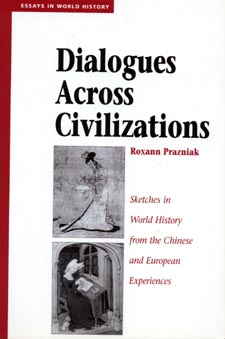| WORLD STUDIES BOOK LIST FOR CHINA |
 |
| WORLD STUDIES BOOK LIST FOR CHINA |
 |
| As with other lists, this is not meant to be the definitive bibliography on the region, in this case China. For the standard works on Chinese history, consult the bibliography in Prazniak. The books below provide a variety of insights into Chinese cultural history. Several of them, as before, emphasize interconnectedness with other cultural histories, reminding us that Chinese history, like any other, is complex and does not take place in a vacuum. |
| S.A.M. Adshead, Central
Asia in World History (1993). Exemplary work on world history, focussing on a region at the hub of cross-cultural trade and learning between China and Southern and West Asia. Chapters on the Mongols, Genghis Khan, Tamerlane, religious internationals, world markets, and contemporary Central Asia. With extensive bibliography.
Jack Gray, Rebellions and Revolutions: China from the 1800s to the 1980s (1990). A comprehensive treatment, linking China's complex recent history to its past.
Eric Hobsbawm, The Age of Extremes: A History of the World, 1914-1991 (1994). The author's fourth volume on world history of the 19th and 20th centuries. Many references to Chinese history, especially as it relates to broader world historical issues, including sections on the Communist Revolution, the Great Leap Forward, and the Cultural Revolution, along with their repercussions.
T.C. Lai & Robert Mok, Jade Flute: The Story of Chinese Music (1981). Describes Chinese classical music in a simple, informative and entertaining manner, with the aid of poems, anecdotes and illustrations. Chapters on the Chinese music system, traditions of Chinese music, the principle of eight kinds of sounds, the ch'in as instruments of the sages, and other instruments. A useful accompaniment to any recordings of traditional Chinese music.
James Loewen, The Mississippi Chinese: Between Black and White (1988). Chronicles the Chinese workers who built U.S. railroads during the 19th and 20th centuries.
Loy Ching-Yuen, The Book of the Heart: Embracing the Tao (1990). Translation of inspiration and poetic teachings by a modern Taoist master. Useful accompaniment to primary sources on Chinese religion, such as the Analects of Confucious or the the Tao-te Ching.
Maoshing Ni, The Yellow Emperor's Classic of Medicine (1995). Illuminates the ancient principals of Chinese medicine, still practiced today by master herbalists and acupuncturists. Chapters on theory and practice, including pulse analysis and meridian pathology.
Roxann Prazniak, Dialogues Across Civilizations: Sketches in World History from the Chinese and European Experiences (1996). An innovative and bold attempt at integrated, comparative history. This work is part of a series of books edited by historians William McNeill and Ross Dunn. The latter is working on a textbook for High School Global Studies that will use a similar, thematic approach. Prazniak is connected to this emerging trend in Global Studies, and this book is a fine example of one way to do comparative history. Traversing philosophy, gender, politics and art, she provides a series of provocative reflections on world history.
Jonathan D. Spence, The Question of Hu (1988). Reconstructs an episode of early 19th century contact between China and Europe, focusing on the story of John Hu, a Chinese Christian, who accompanies a Jesuit minister to France in 1722, and who ends up in an asylum. Probes the depth of faith, madness, and moral obligation in the collision of two cultures.
Ronald Takaki, Strangers from a Different Shore: A History of Asian Americans (1989). Reminds readers that Ellis Island was not the only point of entry for immigrants, with chapters on Chinese, Japanese, and Philippine immigrants, and others, and the communities they established in the U.S. |